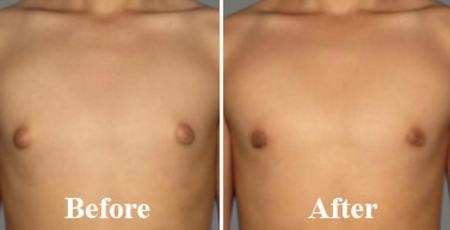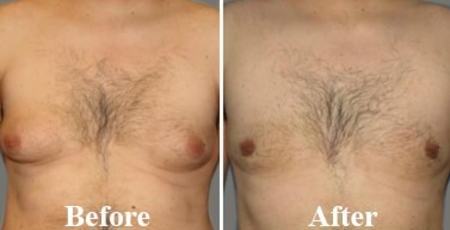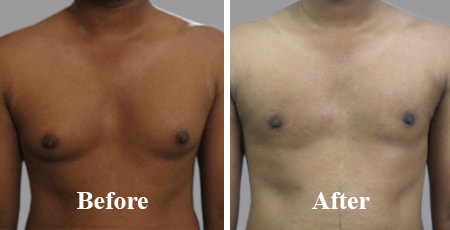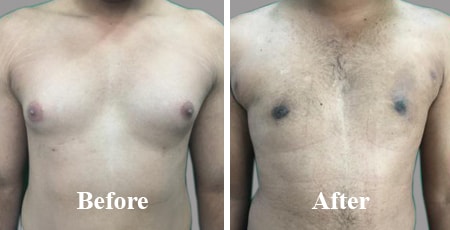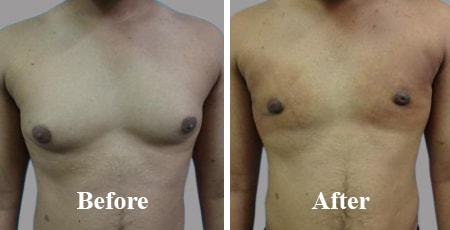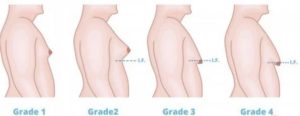Flaunt your Chest not Boobs
Call now & Get Discount: +91 98908 44400
Best Gynecomastia Surgeon in Nashik Get Male Breast Reduction & Gland Removal from Best Surgeon!
Gynecomastia Male Breast Reduction Clinic in Nashik- Get the best treatment for Enlarged Male Breast, Puffy Nipples in India at very affordable cost. Complete guide on Gynecomastia, Causes, Symptoms, Cure and recovery. Find the best Male Breast Reduction Clinic in Nashik.
Dr. Kiran Nerkar, MBBS, DNB (Plastic Surgery), MNAMS.
- Specialties
- Cosmetic/ Plastic Surgeon
- Vascular Surgery
- Hair Transplant Surgeon
- Awards and Recognitions
- Member National Academy of Medical Science
- Professional Memberships
- All India Association of Plastic Surgeons
- Indian Society For Surgery of Hand
- Maharashtra Association of Plastic Surgeons
- Indian Medical Association (IMA)
- Indian Association of Aesthetic Plastic Surgeons (IAAPS)
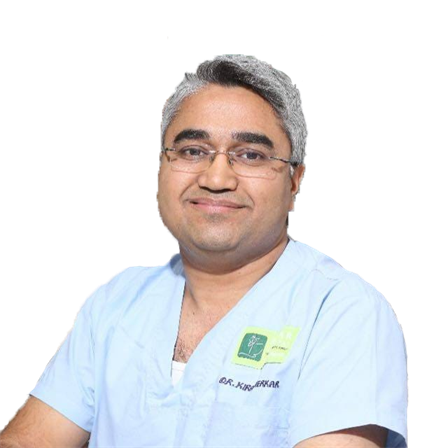
Dr. Kiran Nerkar, a National Board Certified Plastic & Reconstructive Surgeon, graduated from a reputed institute B. J. Medical College & Govt Hospital, Pune. Dr. Nerkar was selected for his Superspeciality training in Plastic & Reconstructive Surgery in a National Board Certified Training Institute MTH, Cochin, Kerala. He underwent aggressive training over five years in managing a variety of aesthetic problems as well as solving reconstructive challenges under eminent faculties of national repute.
Call now & Get Discount: +91 98908 44400
Best Treatment, Lowest Cost, Easy Finance Available, 100% Result
Gynecomastia Surgery Cost in Nashik Know the Cost of Male Breast Reduction Surgery, Deals & Offers in Nashik
Gynecomastia Cost Depends on?
The cost of Gynecomastia Male Breast Reduction Surgery depends on Surgeon’s Qualification, Operative facilities, Technique of liposuction, Gland excision needed or not, Stay Required or not, Anaesthetist Experience, Type of Compression garment & Post care facilities given to patient.
Please fill the form for exact costing of Surgery in your condition.
Contact Us
Aakar Hospital for Plastic & Cosmetic Surgery
Address: 406, Sai Square Commercial Complex, Ahilyadevi Holkar Rd, Near Suyash Hospital, Mumbai Naka, Nashik, Maharashtra 422002
Phone: 098908 44400
Find detailed information about Gynecomastia Causes, Symtoms, Diagnosis, Gynecomastia Grades, Candidates, Myths, Facts, Faq’s & Male Chest Reduction & Reshaping surgery in Nashik. If you are a Doctor from Nashik, You can request your profile on our website & If you are Gynecomastia patient you can find doctors, Ask your doubts about Male breast reduction or read the blogs. We have tried to list best Clinics, doctors & surgeons in & near Nashik. You can fill the form & submit your contact details to fix your free consultation with one of our affiliate doctors in Nashik. To know the approximate cost of Gynecomastia Treatment, click on - http://www.gynecomastiasurgery.co.in/gynecomastia-surgery-cost-financing/.
Gynecomastia surgery and its cost in Nashik
The excess breast tissues and fat get removed to contour the body shape with Male Breast reduction or Gynecomastia Surgery. A flatter and firmer chest area with improved contours and minimal or virtually flatter and firmer chest area is the primary goal of this surgery. To remove excess breast tissues this surgery is usually done with the help of Liposuction and excision techniques. Due to Gynecomastia, men feel socially embarrassed and lack confidence. Around 40 to 60% of men get suffered from this situation. Gynecomastia is lcommon during puberty but may occur at any stage. In most teenagers, in a couple of years, it disappears on its own. But it becomes a cause of concern for them in whom it persists. Both fat and glandular tissue expand the size of breasts in men and usually depend on the underlying cause as well as the age of the patient. There are several clinics available for this surgery at Thakkar Bazar, College Road, Mumbai Naka, Tidke Colony and Gangapur Road in Nashik. Depending on the amount of fat to be removed, the technology used, sculpting needed and other miscellaneous expenses the cost of this surgery ranges from ₹ 65,000 to ₹ 95,000 in Nashik.
The Procedure:
Depending upon the form of gynecomastia the procedure involves the three types of technique. At the intersection of the areola and chest, the incision is made in most cases. Once faded the incision looks small and unnoticeable. A repositioning of the nipple to a higher level is involved in some cases. To contour the chest too we may use liposuction. The condition of enlarged or over the developed breast in men that can occur at any age is called gynecomastia. Hormonal changes, heredity, obesity or the use of certain drugs can be the cause of this condition. The emotional discomfort and your impaired self-confidence can be the result of gynecomastia. Some men simply to hide their condition may even avoid certain physical activities and intimacy. Gynecomastia is characterized by:
- Presence unilaterally (one breast) or bilaterally (both breasts)
- Sometimes excess breast skin
- Excess localized fat
- Excess glandular tissue development
Steps of a gynecomastia procedure:
The following steps are included in a gynecomastia procedure:
Anaesthesia:
During the surgical procedures, medications are administered for your comfort. Intravenous sedation and general anaesthesia are the options included. The best option will be recommended by your doctor.
Liposuction technique:
Liposuction techniques alone may be used in cases where gynecomastia is primarily the result of excess fatty tissue. Through several small incisions a cannula, a thin hollow tube is inserted as required by the technique. The excess fat is removed from the body by vacuum suction after loosening it by the controlled back and forth motion of the cannula. Various liposuction techniques are there that can be used. Before your procedure, the most appropriate technique will be defined for you.
Excision technique:
Excision techniques are recommended to correct gynecomastia when glandular breast tissue or excess skin must be removed. Excision also is necessary for a more natural male contour by repositioning the nipple or reduction of the areola. Depending on the specific conditions and surgical preference incision patterns are varied.
Recovery of gynecomastia surgery:
During your gynecomastia surgery recovery period, as it heals after the surgery, an elastic bandage or support garment may be used to minimize swelling and support your new chest contour and dressings or bandages will be applied to your incisions. To drain any excess blood or fluid that may collect a small, thin tube may be temporarily placed under the skin. You will be given specific instructions. To aid healing and reduce the potential for the infection you will be instructed to take or apply medications orally. At the surgical site or in your general health, you will be instructed to look at specific concerns. Be sure to ask specific questions about your expectations regarding your recovery period by your plastic surgeon.
Nashik district, also known as Nasik district, is a district in Maharashtra, India. The city of Nashik is the administrative headquarters of the district. It is bounded by Dhule district to the north, Jalgaon district to the east, Aurangabad district to the southeast, Ahmadnagar district to the south, Thane district to the southwest, Valsad and Navsari districts of Gujarat to the west, and The Dangs district to the northwest. Administratively, the district is divided into fifteen talukas, which are grouped into four sub-divisions: Nashik sub-division: Dindori, Igatpuri, Nashik, Nashik Road, Peth, Trimbakeshwar,. Malegaon sub-division: Chandwad, Malegaon, Nandgaon. Niphad sub-division: Niphad, Sinnar, Yeola. Kalwan sub-division, Deola, Kalwan, Baglan (Satana), Surgana. The Nashik district is under proposal to be bifiurcated and a separate Malegaon District be carved out of existing Nashik district with the inclusion of the north eastern parts of Nashik district which include Malegaon, Nandgaon, Deola, Baglan, and Kalwan talukas in the proposed Malegaon district.
The information on this site is intended for general purposes only and is not intended to nor implied to be a substitute for professional medical advice relative to specific medical conditions or questions. The information on this website is not a guide to treatment, and it should not replace seeking medical advice from your physician. We do not warrant the accuracy, completeness, correctness, timeliness or usefulness of any information contained herein. In no event Domain.com be liable to anyone for any decision made or action taken in reliance upon the information provided through this website. The photos on this website are of models & are not intended to represent the results that every patient can expect. Surgical results vary greatly from patient to patient and are not guaranteed.
Gynecomastia can be defined as over-development or enlargement of male breast This can be caused due to genetics, hormonal changes, and even certain drugs and medications. This condition may occur one or both the side of the chest. In a simple language, gynecomastia means the presence of excess breast tissues, fat and skin in one or both breasts on a male. People suffering from gynecomastia often feel low self-esteem and low self-confidence. This situation does not affect the person physically but it affects mentally.
Gynecomastia surgery is very simple and quick procedure. It is as similar as breast reduction in females. The gynecomastia surgery helps to remove excess breast tissue, fat and skin to achieve more fatter, firmer appearing male chest.
WHO MIGHT SEEK OUT GYNECOMASTIA SURGERY?
The one who is feeling physically or emotionally discomfort to be a shirtless due to enlargement of the breast:
WHAT CAN GYNECOMASTIA SURGERY ACCOMPLISH?
Reduce the size and weight of the breast
Reduce the size of the areolas (the darker skin around the nipple)
Reshape the breast for a flatter more natural masculine look
Boost self-esteem, confidence, and physical activity
WHAT HAPPENS DURING GYNECOMASTIA SURGERY?
The surgeon typically performed the surgery under general or local anesthesia. The technique to be used completely depends on the surgeon. While consultation doctor will let you about the techniques which is used by him to perform the gynecomastia surgery. It is very patient to patient. The doctor will use the appropriate techniques to achieve the desired result.
Tags: gynecomastia surgery in Nashik, gynecomastia surgery cost in Nashik, gynecomastia treatment in Nashik, Gynecomastia Symptoms in Nashik, Gynecomastia Causes in Nashik, Gynecomastia Before And After Surgery in Nashik, Gynecomastia Surgery Near Me in Nashik, Treating Gynecomastia Without Surgery, Gynecomastia Removal in Nashik, How Much Gynecomastia Surgery in Nashik, Gynecomastia Grades in Nashik, Gynecomastia Cure in Nashik, Gynecomastia Doctors in Nashik, Gynecomastia Post Surgery in Nashik, Gynecomastia Liposuction in Nashik, Gynecomastia Reduction in Nashik, Gynecomastia In Children in Nashik, Gynecomastia Free Consultation
Gynecomastia is swelling of the mammary gland in men. Indeed, the man has two mammary glands located under the nipples ... just like the woman. This swelling of the mammary glands can occur on both sides or only one side and it occurs due to the effects of certain hormones.
Swelling from tumors is not gynecomastia.
When a man's mammary gland has been stimulated by hormones and is swollen, if one does not act quickly enough in treating it, the breast volume can remain troublesome afterward. In this case, alongside a treatment that is a little too late, surgery to remove the gland can make it possible to find an aesthetically more masculine thorax.
When the mammary gland remains swollen and gynecomastia is left untreated, cysts, fibroadenomas, such as in women's breasts can occur. In contrast, it is rare for breast cancer to occur in a man with gynecomastia.
Why do we have gynecomastia?
A man has gynecomastia because there is an imbalance between estrogen-like hormones (which stimulate the proliferation of the mammary gland, for example at puberty in women) and the androgens which slow down this proliferation.
Thus, gynecomastia can be linked to an increase in the level of estrogen hormones or to a lowering of androgen-type hormones (testosterone in particular). Gynecomastia can be confused with what's called lipomastia, which is an increase in the volume of fat around the nipples, without an increase in the volume of the mammary gland itself.
Gynecomastia is linked to a change in the hormonal balance between estrogens and androgens.
- Estrogens stimulate the proliferation of the mammary gland, so if they increase, the gland swells.
- Androgens (including testosterone) on the contrary block the proliferation of the mammary gland, so if they are lowered the gland can swell.
Normal gynecomastia
Many gynecomastias are unrelated to a health problem. These are physiological (or normal) gynecomastias.
In newborns, swelling of the mammary glands is normal, and almost 90% of them have gynecomastia. It is related to the passage of placental hormones (estrogen) through the circulation. It is a transient phenomenon which ceases on its own sometime after birth.
In adolescents, more than half of boys have gynecomastia around the time of puberty. This is a normal phenomenon generally occurring around 13-14 years old and linked to the hormonal phenomena of puberty. It lasts between 6 months and 2 years and it can be scary for a teenager, even if it is commonplace.
In older men, gynecomastia can appear with age after 50 years. The older we get, the more frequent this swelling of the mammary gland is. It is linked to the decrease in androgens over the years.
Gynecomastia related to an abnormality or disease
Some gynecomastias persist after adolescence and are therefore present in adult men. This represents ¼ of cases of gynecomastia in adult men. Medically, it does not have a serious nature, but it can be aesthetically embarrassing.
Gynecomastia with no known cause found
They also represent ¼ of gynecomastia. They are often present in overweight older men, possibly with other unknown factors as well.
- Diseases causing poor functioning of the testes (they make androgens), trauma, surgery, radiotherapy to the testicles can be the cause of gynecomastia.
- Cirrhosis and malnutrition are also causes of gynecomastia,
- Tumors of the testes or adrenal glands (glands that are sources of androgens),
- Chronic renal failure,
- And other diseases that are much rarer.
The symptom of gynecomastia
Gynecomastia is an increase in the size of the mammary gland. It is perceived by feeling, under the nipple, a swollen gland. This can be discovered on examination by a doctor or by the man himself who then consults because he is embarrassed.
Since gynecomastia is linked to hormones circulating in the blood, both mammary glands are often affected. However, sometimes only one of the two glands can swell, because the tissues of the two mammary glands may have different sensitivity to hormones.
It is also important to observe whether there is any discharge from the nipples by pinching around the areola.
Swelling in the nipples in men can also be lipomastia, an increase in the volume of fat without an increase in the volume of the mammary gland. The consistency is then softer, is not centered on the nipple and is often associated with excess weight.
People at risk for gynecomastia
- Newborns (normal gynecomastia)
- Adolescents (normal gynecomastia)
- Men over the age of 50 (most often normal gynecomastia unrelated to disease) are affected in approximately 50% of cases.
- Overweight men have a higher risk of gynecomastia. This is because fatty tissue has a hormonal effect. It works by converting androgens (anti-gynecomastia) into estrogens (pro-gynecomastia).
- Men taking certain drugs that can affect hormones.
- Men with diseases in which hormones are involved.
When should you consult?
When a newborn or teenager has gynecomastia, it is not necessary to see a doctor.
In the case of a teenager, if the gynecomastia lasts more than a year or two, if it seems very important, it can be reassuring to seek the advice of a doctor, however.
The doctor to consult is the general practitioner or a specialist in hormones, the endocrinologist.
In a young (non-adolescent) man with swelling of the mammary glands on one or both sides, a doctor should be seen.
If you are taking medication, you should read the package leaflets and side effects to see if this treatment is likely to lead to gynecomastia. In this case, it is often possible for the doctor to change the treatment.
Exams
- Examination by the doctor: When there is swelling under the nipples, the doctor begins by examining the man. He feels this swelling, pinches the nipples to see if there is a discharge.
- He also examines the testes, the thyroid gland, palpates the liver as these organs are involved in hormonal functioning and an abnormality may be involved in gynecomastia.
- Complementary examinations: these examinations are not always useful because a large number of gynecomastias do not show any disease ...
When these examinations are necessary, they may consist of a breast ultrasound (completely painless ultrasound examination). Sometimes a mammogram (x-ray) may be ordered as well as an ultrasound of the testes and thyroid gland.
- Blood test: it is useful for determining what is happening with the hormones of a man with gynecomastia. It is therefore a question of a thorough hormonal assessment (with in particular a dosage of , total and bioavailable testosterone, beta-hCG and SHBG).
Opinion of our doctor
Dr Catherine Solano general practitioner and andrologist:
"Swelling of the breasts in adolescent boys is very common since more than half of them are affected. It is important to reassure them and tell them that it should pass in a few months (maximum 2 years). An older man, it is a frequent phenomenon which, if it is embarrassing may justify a cosmetic surgery. And then it is essential to read the undesirable effects of a drug on the leaflet in the event of occurrence of gynecomastia, because this is the most common cause ... "
Treatments
Medical treatment for abnormal gynecomastia should be prompt, within the first 6 to 12 months, when the gland is swollen and tender. Indeed, thereafter, even if the treatment restores a satisfactory hormonal balance, the gland may retain certain volume, the treatment no longer succeeding in making it deflate.
- The first treatment is of course that of the cause. Stop the drug that is the source of gynecomastia to prefer a drug that does not have this adverse effect, treat the disease in question, lose weight ...
- The treatment of gynecomastia, aimed at reducing the size and swelling of the mammary gland can consist of a drug like because they allow a reduction in the volume of the gland in more than 80% of cases. can also be used but are rather less effective.
- In the event of DALA, androgen deficiency linked to age (lowering of testosterone levels with age), a man with gynecomastia can receive testosterone-based treatment when there is no contraindication.
- Surgery allows a man with gynecomastia to have his mammary gland removed and regain proper aesthetics. However, this should not prevent treatment of the defect in question if it exists. The scar is then around the areola and it is extremely discreet or even invisible after a certain healing time.
There are also suction techniques with a scar under the armpit or a very small incision around the areola.
Gynecomastia is characterized by excessive development of breasts on a male subject, newborn, child or adult. It can happen on one side or both, symmetrically or not.
Gynecomastia is normal and common in certain periods of life: for example, in a newborn baby due to the presence of maternal hormones or in adolescence (40% of boys.)
Note: this should not be confused with the presence of "fake" breasts due to obesity or excess weight. Gynecomastia is a real increase in the mammary gland in men.
Causes of gynecomastia
There are many causes for gynecomastia. The most frequent are:
- A hormonal imbalance: at birth, in adolescence, in the elderly.
- A disease: kidney problems, thyroid, cirrhosis, cancerous tumor (in the testicles, for example.)
- Taking certain medications.
In many cases, there is no underlying cause that could explain the increase in mammary glands. This form of gynecomastia is called “idiopathic” or “essential”.
Who is affected by gynecomastia? What are the risk factors?
Gynecomastia affects men of any age:
- 40 to 65% of boys between 10 and 15 see an increase in the size of one or both breasts. This usually disappears in about 2 years.
- It is estimated that about 4% of adult men have more or less severe gynecomastia.
The risk factors are linked to the diseases mentioned above as well as to the taking of certain drugs.
Contagion
Gynecomastia is not contagious.
The main symptoms of gynecomastia
The signs of gynecomastia are:
- Swelling of one or both breasts, proportionally or not.
- Sensitivity to touch, or when clothes rub.
- Pain more or less pronounced.
Diagnosis of gynecomastia
The diagnosis of gynecomastia aims above all to ensure that it is indeed an increase in the mammary gland and not a fatty accumulation as is often the case in overweight people. This is done by a full examination and blood tests. Depending on the case, an ultrasound, mammography or localized biopsy is also considered if there is any doubt about the possible presence of a tumor.
Then the staff try to find out what is the underlying cause (illness, medical treatment) that is causing the breast augmentation.
When the problem is present in a young subject in full puberty, it is usually considered a follow-up over a few months before proceeding to the examinations, since the evolution of the gynecomastia can regress quickly.
Possible risks of complications
Complications of gynecomastia are directly related to the underlying cause of the disease.
When no cause is detected, however, there is a risk in some men of experiencing this disease very badly, which sometimes causes isolation and depression.
Treatment of gynecomastia
Treatment for gynecomastia depends on the underlying disease causing it, if any.
When no cause is found, consider:
- Patience (in the case of teens) since the disorder usually goes away on its own.
- Applying a gel to the affected area.
- Hormonal treatment.
- Breast reduction surgery, in the most serious cases.
Prevention of gynecomastia
Real gynecomastia (enlargement of the mammary gland) cannot be avoided because it is often unexplained or has specific causes.
The formation of “fake” breasts caused by being overweight is eliminated by losing weight and maintaining that new healthy weight.
